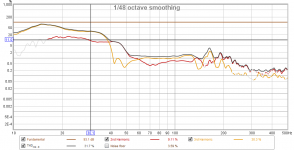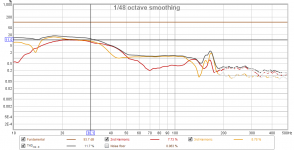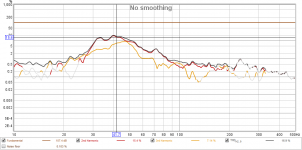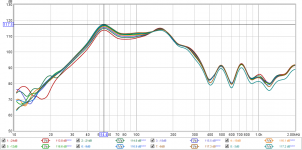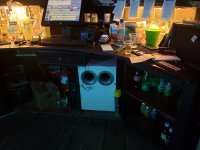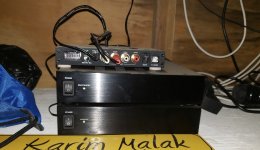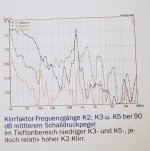Hmm, so what else is distortion but what you just mentioned ?? Good grief man, are you trolling me or something?
Distortion can be of a higher order, which will be filtered by the inheritend bandpass, it can be mechanical noise, air compression in the port (which will result in audible higher frequencies because it's not 'filtered'), it can, no, it WILL be non-linear distortion and, ofcourse, direct mechanical noise, which will be audible and there will be distortion because of the power compression too. Exceeding the max excursion results in a LOT non-linear distortion. All of which are audible, regardless of it being a BP or not.
Yes, *some* mechanical noise may make it out of the port - most of it however is filtered like basically everything else above the bandpass subwoofer's upper cutoff frequency, because the vented chamber acts as the LP filter - and ANY sound that originates in that chamber is subjected to that filter, including any distortion and mechanical noise generated by the driver.
That's a gross misunderstanding of the BP principle. And that's a severe misunderstanding of the sound of a BP subwoofer. Compression does changes the sound, mechanical stress does sound different. If you keep ignoring the changes in sound, it will result in a killed sub, no matter what you do otherwise. The logical solution is to just use 2-4 subs instead - which can deliver the needed spl. To gain 1-1,5 dB by modifying the sub is simply futile. Put there more subs and everything's fine. Using the same or a different driver will simply not give you the needed headroom. Period.
The Enigma is actually pretty good at doing just that, as is measured out of band noise is 15~20dB below its passband, when measured with a sine sweep. Even when driven to its 10% THD limit in its passband (which occurs around 40 Hz, and at 23.3V, the equivalent of 70W into 8 ohms (the driver's power rating, btw), measured distortion at higher bass frequencies (where most bass in music is found) is significantly lower. At 50 Hz it's just above 2% and above that it's around 1% or less. Good luck hearing that when playing sine waves, much less music. When playing most music, the only indicator that this sub is at its limits is that it just stops getting louder.
You surely haven't measured the THD at the used spl. At PA levels the thd often exceeds 30% and for a BP it typically exceeds even 40% or more. That's still fine since the ear is extremely insensitive to distortion in the bass or even more in the sub-bass. What's more important is the source of the distortion. K2 or even K3 is not that 'harming' in the bass. Non-linear distortion is much, MUCH worse though. And that's where you can recognize your sub is at its limit. Learn how the non-linear distortion sounds and you'll be able to save your subs from destruction.
1. There is very little vent compression within this subwoofer's design limits. (See post #54). Any noticeable compression would have have shown up in the linearity testing.
2. The subwoofer is NOT being driven at "PA levels" It's been driven by a 100W amplifier (See post #60) and it's been tested to remain under 10% THD in its passband up to 70W. And that THD was measured without the use of 30 Hz HP filter I enabled for the subwoofer's operation in the bar, so unless they suddenly decide to feature sine waves instead of music on their background audio system, distortion generated by the subwoofer will remain at or below 10%.
3. ANY distortion created by within the vented section of the bandpass subwoofer WILL be filtered by the acoustic HP filter once it is outside of the filter's passband, period. The filter does not know and does not care if that distortion is linear or non-linear - if that distortion manifests itself at frequencies higher than the passband, it will be subjected to the acoustic filter.
2. The subwoofer is NOT being driven at "PA levels" It's been driven by a 100W amplifier (See post #60) and it's been tested to remain under 10% THD in its passband up to 70W. And that THD was measured without the use of 30 Hz HP filter I enabled for the subwoofer's operation in the bar, so unless they suddenly decide to feature sine waves instead of music on their background audio system, distortion generated by the subwoofer will remain at or below 10%.
3. ANY distortion created by within the vented section of the bandpass subwoofer WILL be filtered by the acoustic HP filter once it is outside of the filter's passband, period. The filter does not know and does not care if that distortion is linear or non-linear - if that distortion manifests itself at frequencies higher than the passband, it will be subjected to the acoustic filter.
1. There is very little vent compression within this subwoofer's design limits. (See post #54). Any noticeable compression would have have shown up in the linearity testing.
Compression does not show in linearity. It shows in impulse response and distortion.
2. The subwoofer is NOT being driven at "PA levels" It's been driven by a 100W amplifier (See post #60) and it's been tested to remain under 10% THD in its passband up to 70W. And that THD was measured without the use of 30 Hz HP filter I enabled for the subwoofer's operation in the bar, so unless they suddenly decide to feature sine waves instead of music on their background audio system, distortion generated by the subwoofer will remain at or below 10%.
HAHAHA! You've built the subwoofer of the century! Congratulations!
Seriously, most subwoofers pass the 10% distortion below 5W @30Hz. Yours isn't an exception. It is very obvious you've never measured distortion on a subwoofer.
Seriously, put there 2 or more subs. That will help a ton more than any modifications you're doing. It's used as a PA and it's clear it isn't enough.
Seriously, that sub is used beyond its capacity. That's not your fault but denying that it happens doesn't change that.
3. ANY distortion created by within the vented section of the bandpass subwoofer WILL be filtered by the acoustic HP filter once it is outside of the filter's passband, period.
Anything that is created by the port WILL exit the port because the port is the filter, period. If you haven't realized that, you don't know how a BP works.
Compression does not show in linearity.
Clearly you have no idea what "linearity" means.
Seriously, most subwoofers pass the 10% distortion below 5W @30Hz.
Maybe most of YOUR subwoofers are like that, LOL. This one measures differently
Yours isn't an exception. It is very obvious you've never measured distortion on a subwoofer.
I've both measured and posted the measurements here. It's very obvious you either don't know what you're talking about, or you're trolling. I'm going with the latter for now. Stay off my thread from now on please. Your posts are adding no value to the content.
Technically, a BR, BP4, BP6, and TH could all be a 7 board enclosure not including bracing.
If you put some rather severe limits on the shape of the enclosure
I thought I might share some more info on the distortion / linearity testing just in case anyone's interested, and also provide some background on why I chose to use a 30 Hz HP filter with this build.
For my linearity tests, I usually run some quick sine sweeps (not long enough to heat up the voice coil by any noticeable amount) and use REW (test signal set to -3dB) to measure the frequency response and distortion until it reaches about 10% in the passband (for the Enigma, the passband is about -3 dB +1.5 dB from 38 Hz to 115 Hz). Note: This requires some careful positioning of the mic to get right, which also requires a bit of experimentation - too close to the subwoofer and the mic gets overload, too far from the subwoofer and too much of the environment gets into the measurements. The start and end of the sine sweep also needs to be chosen carefully so you don't end up trying to push the driver significantly pass its excursion limits outside of the subwoofer's passband.
Once I've established the best position for the mic, I redo the measurement, and for each measurement cycle I drop the test signal by 1 dB or 3 dB, depending on how much detail I'm looking for. I usually stop around -24 or -27 dB. I then adjust the measurements in REW by the same amount that I dropped the signal. If the subwoofer remained perfectly linear for each signal level, the measurements will also align perfectly (yes, I'm assuming that the mic remains linear throughout the measurements. In any case, if it doesn't, it will make the results look worse, not better). Vent compression shows up pretty quickly in these tests, based on some of the results I've seen. So does any in-line limiting that may be in place (like the lightbulb type protection that Bose likes to use). Another thing - I choose 10% THD as my limit, but it's perfectly acceptable to choose a higher distortion point, particularly if the subwoofer is destined for PA use.
As for the choice of the 30 Hz filter?
The first image shows Enigma2's distortion when driven at a level equivalent to 70W into 8 ohms. While distortion at 40 Hz is around 10%, distortion at 30 Hz is almost 32% at the same signal level and continues to rise below that, and it consists primarily of odd-order distortion, a clear sign that the driver is exceeding its linear excursion limits.
The second image shows Enigma2's distortion at 6dB below the "70W" reference. Distortion at 30 Hz is now much lower, at just under 12%. So, it stands to reason that if I use a HP filter at 30 Hz (e.g. 24dB/octave, -6dB at the corner frequency of 30 Hz), then I wouldn't have to worry about the driver being overdriven at any frequency at or below the subwoofer's passband, once it's driven at 70W or below.
In reality, I am being over-cautious doing this, as the vast majority of music doesn't feature any information below 40 Hz (and a good portion of that doesn't have much below 50 Hz either), but I wanted the new driver in the Enigma2 to have the best chance of survival, given the environment that it's going to be used in (and what tends to happen at that bar). Maybe after a few months, if it has survived intact, I'll move the HP filter down to about 20~25 Hz, to minimize its impact on the subwoofer's passband.
The third image shows what the impact of such a filter can have on the distortion profile. No, that's not the Enigma - that's the measured distortion for one of my brother's KSubs. The KSub is an active 4th order bandpass design using 2 12" drivers, and from the distortion profile, it looks like there's a 35 Hz (or even higher) HP filter applied. The inband distortion of this KSub was quite a bit higher than I expected, but I didn't have the time to take it apart and find out why.
For my linearity tests, I usually run some quick sine sweeps (not long enough to heat up the voice coil by any noticeable amount) and use REW (test signal set to -3dB) to measure the frequency response and distortion until it reaches about 10% in the passband (for the Enigma, the passband is about -3 dB +1.5 dB from 38 Hz to 115 Hz). Note: This requires some careful positioning of the mic to get right, which also requires a bit of experimentation - too close to the subwoofer and the mic gets overload, too far from the subwoofer and too much of the environment gets into the measurements. The start and end of the sine sweep also needs to be chosen carefully so you don't end up trying to push the driver significantly pass its excursion limits outside of the subwoofer's passband.
Once I've established the best position for the mic, I redo the measurement, and for each measurement cycle I drop the test signal by 1 dB or 3 dB, depending on how much detail I'm looking for. I usually stop around -24 or -27 dB. I then adjust the measurements in REW by the same amount that I dropped the signal. If the subwoofer remained perfectly linear for each signal level, the measurements will also align perfectly (yes, I'm assuming that the mic remains linear throughout the measurements. In any case, if it doesn't, it will make the results look worse, not better). Vent compression shows up pretty quickly in these tests, based on some of the results I've seen. So does any in-line limiting that may be in place (like the lightbulb type protection that Bose likes to use). Another thing - I choose 10% THD as my limit, but it's perfectly acceptable to choose a higher distortion point, particularly if the subwoofer is destined for PA use.
As for the choice of the 30 Hz filter?
The first image shows Enigma2's distortion when driven at a level equivalent to 70W into 8 ohms. While distortion at 40 Hz is around 10%, distortion at 30 Hz is almost 32% at the same signal level and continues to rise below that, and it consists primarily of odd-order distortion, a clear sign that the driver is exceeding its linear excursion limits.
The second image shows Enigma2's distortion at 6dB below the "70W" reference. Distortion at 30 Hz is now much lower, at just under 12%. So, it stands to reason that if I use a HP filter at 30 Hz (e.g. 24dB/octave, -6dB at the corner frequency of 30 Hz), then I wouldn't have to worry about the driver being overdriven at any frequency at or below the subwoofer's passband, once it's driven at 70W or below.
In reality, I am being over-cautious doing this, as the vast majority of music doesn't feature any information below 40 Hz (and a good portion of that doesn't have much below 50 Hz either), but I wanted the new driver in the Enigma2 to have the best chance of survival, given the environment that it's going to be used in (and what tends to happen at that bar). Maybe after a few months, if it has survived intact, I'll move the HP filter down to about 20~25 Hz, to minimize its impact on the subwoofer's passband.
The third image shows what the impact of such a filter can have on the distortion profile. No, that's not the Enigma - that's the measured distortion for one of my brother's KSubs. The KSub is an active 4th order bandpass design using 2 12" drivers, and from the distortion profile, it looks like there's a 35 Hz (or even higher) HP filter applied. The inband distortion of this KSub was quite a bit higher than I expected, but I didn't have the time to take it apart and find out why.
Attachments
For comparison purposes, here's a linearity test of the Bose AM7 bass module that was replaced by the Enigma2. The result is not as clean as the Enigma2's, and I suspect at least one of the drivers in the AM7 bass module has some sort of mechanical damage. Not only is it noticeably non-linear around 50 Hz, but the non-linearity is the reverse of what I'd expect to happen (instead of the output compressing, it actually expanded a bit as signal level was increased from -24 dB to -3 dB). And there's definitely some sort of limiting going on at -3dB - check how the graph deviates from the others about 200 Hz.
I'm going to be picking up the AM7 bass module tomorrow to take a closer look at it, and to see if I'm correct about the drivers.
I'm going to be picking up the AM7 bass module tomorrow to take a closer look at it, and to see if I'm correct about the drivers.
Attachments
As for the choice of the 30 Hz filter?
In reality, I am being over-cautious doing this, as the vast majority of music doesn't feature any information below 40 Hz (and a good portion of that doesn't have much below 50 Hz either)
I HATE when you so called audiophiles make that statement. You should state the majority of the music YOU listen to isn't below 40hz. There is plenty of Hip Hop, Dubstep, and EDM music below 40hz. If you are such an audiophile, then you should design your speaker system to play the lowest note of a piano or pipe organ. So called audiophiles should listen to ALL types of music. And no, I don't consider myself an audiophile. If it ain't Hip Hop or basshead instrumentals, then it don't get played in my crib or rides. Basically, I prefer beats only seeing that most people ain't saying nothing worth a d@mn.
I HATE when you so called audiophiles make that statement.
LOL - I wouldn't call myself an audiophile. You'll never hear me waxing on about how cables make a difference for example. I just know what type of music the bar plays, and little or none of it features any information below 40 Hz, much less 30 Hz, and even if it did, their main system wouldn't be able to reproduce it anyway. Their main system, for example, which they seem happy with, features KSubs for bass, and those are already -6 dB @ 48 Hz and -10dB @ 44 Hz. And their customers don't appear to be leaving the bar because the subs don't go 10 Hz deeper
For home use my DIY sub digs a lot deeper (it easily gets down to 20 Hz), but it's also big and inefficient - not really the best match for use in that bar, though it might be fun one day to plug it in there to see if the customers notice any difference
Clearly you have no idea what "linearity" means.
If you still instinst on that distortion numbers, you clearly have no grasp at all what distortion looks like in the sub range. Even less what it does at a BP.
Maybe most of YOUR subwoofers are like that, LOL. This one measures differently.
Either it does measure 'differntely' but got no spl at all or you've got no grasp at measuring at all. Really, measure ANY sub at the power you've claimed you've measured you sub and you'll realize it's absoultely sheer imposible to get your claims at anything below a 28" sub or you are plain delusional about your own 'wonder' sub.
I've both measured and posted the measurements here. It's very obvious you either don't know what you're talking about, or you're trolling. I'm going with the latter for now. Stay off my thread from now on please. Your posts are adding no value to the content.
You simply don't even fathom how far off you are with your claims. What you claim that's not even physical possible with such a driver of that size! I know why you want me off of your thread, but sorry, I won't shut up because your claims are so dead wrong!
If you still instinst on that distortion numbers, you clearly have no grasp at all what distortion looks like in the sub range. Even less what it does at a BP.
ROFL, well maybe I've built the "bumblebee" of subwoofers then.
BTW, it continues to perform well in its designed role, and my brother continues to be impressed with the results.
Keep posting however if it makes you feel any better.
ROFL, well maybe I've built the "bumblebee" of subwoofers then.
I'll opt to you don't know how to measure it. Or you'd just claimed a valute you've reasoned would be 'great'.
BTW, it continues to perform well in its designed role, and my brother continues to be impressed with the results.
As I already said, the human ear is quite insensitve to distorion in the sub range. That means, it does not contradict 'impressive' results, as these are neither actually measured nor compared to the performance of other subs. Sure, I do not deny they do what they're supposed to do at all. Neither do I doubt the ppl in the bar like how it sounds. I do, however, doubt your 'measurements' because that numbers are just delusional, such BP subs are typical at 30-50% THD at your claimed frequency and power/spl figures. If you stick to your figures, send the data in to ANY speaker manufacturers, they'll be absolutely happy to get their hands on it. You'd make millions, no, BILLIONS by selling that sub!
Keep posting however if it makes you feel any better.
It does not. In fact, it's rather sad to prove someone delusional to be wrong. There are no 'winners', everyone loses facing the reality.
Some quick pictures, taken of the sub in operation.
First one with the sub located under the bar (yes, yes, yes, not the ideal location - I wanted to put it in a corner to get the best results, but the bar is small, they'd already wired up that spot for a subwoofer, and there were no corners available!). Sigh - that's the kind of thing that happens when the audio guy is called in AFTER the bar is built to give advice and produce solutions. Well at least the subwoofer's bandpass arrangement makes sure that no-one can easily throw a drink on the driver (unless of course they throw said drink through one of the vents).
The second one shows the amps and DSP-408 hooked up. Sort of a "temporary" install, as they were going to do some cleanup work at the bar and I didn't want to do anything really permanent before that happened. If you know the size of the DSP-408, you'd know that these amps are pretty tiny. Dust appears to be an issue. In the past, I've made plastic inserts to protect important equipment input/output ports from dust (or just taped them up) - looks like I'll have to do so for that DSP-408.
First one with the sub located under the bar (yes, yes, yes, not the ideal location - I wanted to put it in a corner to get the best results, but the bar is small, they'd already wired up that spot for a subwoofer, and there were no corners available!). Sigh - that's the kind of thing that happens when the audio guy is called in AFTER the bar is built to give advice and produce solutions. Well at least the subwoofer's bandpass arrangement makes sure that no-one can easily throw a drink on the driver (unless of course they throw said drink through one of the vents).
The second one shows the amps and DSP-408 hooked up. Sort of a "temporary" install, as they were going to do some cleanup work at the bar and I didn't want to do anything really permanent before that happened. If you know the size of the DSP-408, you'd know that these amps are pretty tiny. Dust appears to be an issue. In the past, I've made plastic inserts to protect important equipment input/output ports from dust (or just taped them up) - looks like I'll have to do so for that DSP-408.
Attachments
I've never reported a single post on diyaudio in my life, but this is ridiculous. Chill out dude.
As if you'd be the one who'd have seen the return of Jesus.
Here's a measurement of a Wavecor Subwoofer (SW280WA01), with the same Xmax as his driver, which exceeds 1% distortion at 100Hz at just one single Watt!. And 5% at 30 Hz. Again, at just a single one Watt.
You want to report me? Yes, please do so, but please give a prove that what I said is wrong and post a measurement at SEVENTY WATT of ANY BP subwoofer with a single 10" driver with 10% or less THD at 30 Hz and 70 Watt!
Attachments
You want to report me? Yes, please do so, but please give a prove that what I said is wrong and post a measurement at SEVENTY WATT of ANY BP subwoofer with a single 10" driver with 10% or less THD at 30 Hz and 70 Watt!
When I referred to "10%", I was referring to the subwoofer's useable PASSBAND, which is about 38 Hz up to about 115 Hz, going by the -3dB points (some people go by -6dB points, others by -10dB points, I prefer not to engage in that sort of marketing-speak).
Go back to my previous posts and you'll see that I always make a point of referring to the passband when quoting the distortion figures for the subwoofer. 30 Hz is BELOW the subwoofer's passband. Distortion there is higher of course at 70W, hence the use of the HP filter that I referred to in Post #87.
Now, if you have a problem with the measured distortion that I've quoted for the subwoofer in its passband, then take it up with the creators of REW, the software I use for measurement purposes. Because the results of the measurements are pretty clear on that subject and there's not much you can get wrong in the measurement process.
BTW, that graph you provided really doesn't prove much, because there was no mention of what alignment (if any) the driver was used in for that measurement, and you know that will have a significant impact on the measured distortion.
When I referred to "10%", I was referring to the subwoofer's useable PASSBAND, which is about 38 Hz up to about 115 Hz, going by the -3dB points (some people go by -6dB points, others by -10dB points, I prefer not to engage in that sort of marketing-speak).
You've definitely said something different before. But that does not matter because also at 38 or even 50Hz that's simply not physically possible.
Now, if you have a problem with the measured distortion that I've quoted for the subwoofer in its passband, then take it up with the creators of REW, the software I use for measurement purposes. Because the results of the measurements are pretty clear on that subject and there's not much you can get wrong in the measurement process.
As I already said, that measurement is simply not possible. It does not matter if it's because of your inability to conduct a proper measurement or because your measurement chain does not work (how did you not notice that previously?!). And for faults in the measurements, it always shows up as higher distortion, not lower, which you can re-read in the REW help.
BTW, that graph you provided really doesn't prove much, because there was no mention of what alignment (if any) the driver was used in for that measurement, and you know that will have a significant impact on the measured distortion.
It was in a standard baffle, free air measurement. A BP enclosure would only introduce more distortions. And Hobby Hifi magazines Dipl.-Ing. Bernd Timmermanns (V.i.S.d.P.) is a renowned technician and does the magazines since ~25 years (or even longer, he's at the 100th issue of his 2-monthly magazine and was measuring and publishing in other magazines before). A BP would only increase the distortion anyway.
You've definitely said something different before.
Now you're presuming to tell me what I did or didn't say. Go back through my posts on this thread and you'll see that almost every time I referred to the Enigma's distortion I also referred to its passband. I even POSTED a graph that shows the distortion for the subwoofer rising above 10% at frequencies lower than its passband. One of the images even has the cursor at 30 Hz, showing 30% THD. Does your Internet browser show pictures as well as text?
BTW, I've detailed the measurement process in Post #87. See if you see anything in the process that would produce distortion measurements that are LOWER than what the subwoofer actually produces. The only thing that sticks out at me is perhaps the sweep length (unfortunately I didn't record it, but I believe that I used 512K long test signals - REW suggests using 1M long test signals as shorter ones apparently result in less accurate harmonic information in the resulting distortion graph). OTOH, I don't run the sweep all the way to 20kHz, but usually stop at 2kHz or lower, so even though the sweep is shorter, it should contain more information about the covered spectrum. I may have to run another test with different test signal lengths to see how much of a difference that actually makes at bass frequencies.
As mentioned previously, the bandpass alignment will filter any distortion produced by the driver, so you might actually see reduced, not increased, distortion results, in its passband. If, for example, the acoustic filter results in a response that's cut 3dB at 115 Hz, it doesn't care if the driver was trying to produce a 115 Hz signal, or that 115 Hz was 2nd HD from a 67.5 Hz signal that the driver was trying to produce. The level of that filtering will depend on the width of the passband (one of the reasons why I don't like wide-bandwith bandpass designs that much), and of course the fundamental frequency that it's trying to produce. For this particular build, 2nd HD from a 40 Hz tone will not be impacted by the acoustic filter (because at 80 Hz it will still be in the passband), but 2nd HD from a 80 Hz tone certainly will be. 3rd HD (and higher) from a 40 Hz tone will also be reduced in level by the acoustic filter. You can actually see this distortion-filtering effect in the distortion curves that I added to this thread - look at the shapes of the curves and compare them to the subwoofer's HP cutoff around 115 Hz.
Seriously, most subwoofers pass the 10% distortion below 5W @30Hz. Yours isn't an exception. It is very obvious you've never measured distortion on a subwoofer.
Please post some of your measurements of subwoofers here to add context to your claims.
But that does not matter because also at 38 or even 50Hz that's simply not physically possible.
This statement is factually incorrect.
It is possible. Easily so.
You claimed something is impossible in the face of clear evidence to the contrary and then claimed the evidence is suspect due to user error. This seems like blatant trolling of the OP to me.
It was in a standard baffle, free air measurement. A BP enclosure would only introduce more distortions.
This statement is also false. This statement would require a large number of qualifiers to even be considered with any seriousness.
It is NEVER that simple.
- Home
- Loudspeakers
- Subwoofers
- Rebuilding the Enigma...
